
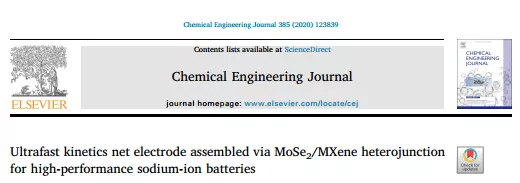
【Research Background】
In recent years, mankind has faced a severe shortage of fossil fuels and an environmental crisis. The most promising way to solve this series of problems is to develop batteries with abundant natural resources, low cost, environmentally friendly, and high specific capacity. Since the introduction of lithium-ion batteries (LIBs) in 1976, the lithium-ion battery industry has developed significantly in the past half century. High specific capacity LIB is widely used in electric vehicles, electronics, large-scale energy storage, etc. However, the low content of lithium sources on the earth (20 ppm) limits the large-scale application of LIBs. Compared with lithium, the abundance of Na / Na + in the lithosphere is about 23000 ppm, which seems to be inexhaustible and inexhaustible. At the same time, the redox potential of Na / Na + (-2.71V vs SHE) is close to Li / Li +, which guarantees the high energy density of rechargeable batteries. Because of these advantages, sodium ion batteries (SIBs) are becoming candidates for the next generation of energy storage equipment. But the Na + ion radius (1.02 Å) is much larger than the Li + ion radius (0.76 Å). Excessive ionic radii hinder the insertion / extraction of Na + in traditional anode materials such as graphite. This feature also results in slow reaction kinetics and high diffusion barriers. Therefore, it is currently important to find a negative electrode material suitable for SIB.
[Achievement Profile]
Recently, Professor Jiang Yang of Hefei University of Technology cooperated with Professor Dabin Yu of the National Defense University of Science and Technology of China to publish an article in the internationally renowned academic journal Chemical Engineering Journal entitled: Ultrafast kinetics net electrode assembled via MoSe2 / MXene heterojunction for high-performance sodium- A research paper on ion batteries. This research prepared a new MoSe2 / MXene heterojunction assembled ultrafast dynamic mesh electrode by simple hydrothermal method and thermal annealing method. By utilizing the Van der Waals interaction between MoSe2 and MXene, the volume change during the sodium ion insertion / extraction process is effectively suppressed, and the reaction kinetics is greatly enhanced. At the same time, DFT calculations show that the high conductivity and ionic conductivity provided by the unique MXene-based net heterostructure of the hybrid material (lower diffusion barrier between Na + / MXene ~ 0.066 eV) are very beneficial for sodium Transportation, so it has excellent rate performance and long cycle capabilities.
[Picture and text guide]
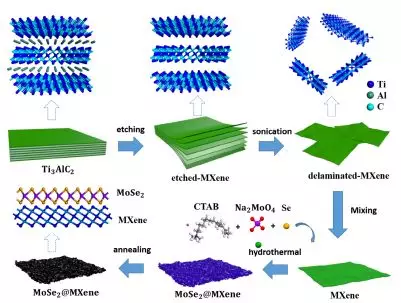
Figure 1. Schematic of the synthesis of single-layer MXene and MoSe2 / MXene heterojunctions
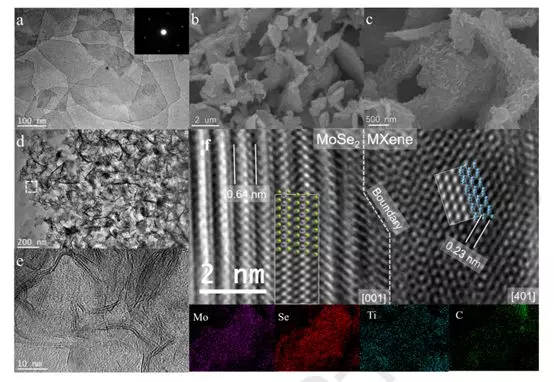
Figure 2. a) TEM images of Ti3C2Tx MXene nanoplates bc) FESEM images of MoSe2 / MXene heterojunction at different magnifications de) TEM images of MoSe2 / MXene heterojunction at different magnifications f) MoSe2 / MXene hetero HRTEM and mapping analysis of massive junctions, illustration: Crystal structure and simulation of HRTEM images of MoSe2 and MXene, Mo, Se, Ti, C element mapping
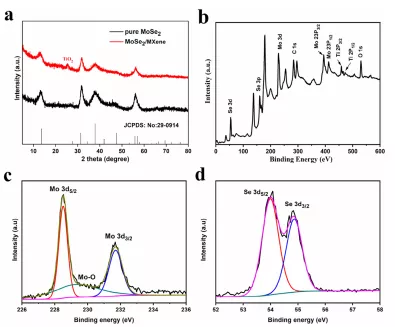
Figure 3. a) XRD pattern of MoSe2 / MXene heterojunction and MoSe2; b) XPS pattern of MoSe2 / MXene heterojunction c) High resolution measurement spectrum of Mo 3d and d) Se 3d
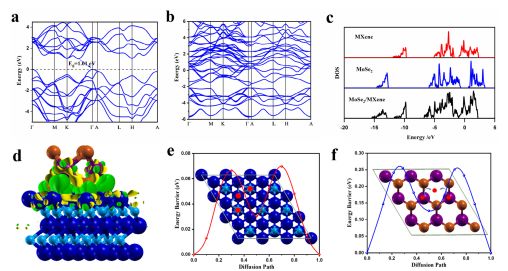
Figure 4. a) Band structure of MoSe2 b) Band structure of MXene c) Energy density of MXene, MoSe2, and MoSe2 / MXene heterojunctions d) Charge density difference of MoSe2 / MXene heterojunction. Energy diffusion paths and calculated energy barriers of monosodium on e) MXene and f) MoSe2.
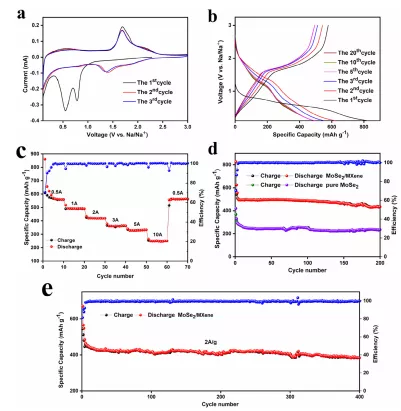
Figure 5. a) CV curves of MoSe2 / MXene at a scan rate of 0.1 mVs-1 in the range of 0.1-3 V b) discharge / charge curves of MoSe2 / MXene at a current of 1 A g-1 c) in different cycles Charge and discharge capacity of MoSe2 / MXene at current rate d) Cycle performance of MoSe2 / MXene and MoSe2 at a current density of 1 A g-1 e) Long cycle performance of MoSe2 / MXene at 2A g-1.
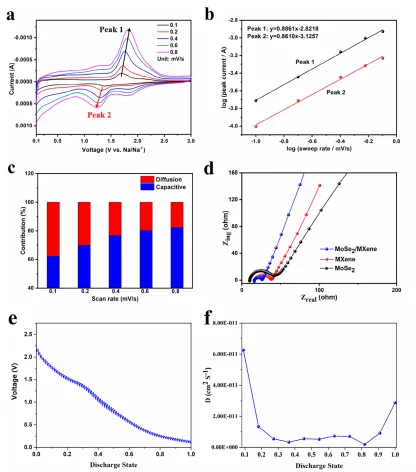
Figure 6. a) CV curve of MoSe2 / MXene at 0.1-0.8mV s-1 b) Logarithm I vs. logarithmic V c) Contribution ratio of capacitance capacity of MoSe2 / MXene at different scan rates d) Nyquist plots of MoSe2 / MXene, MXene and MoSe2 before cycling e) GITT test of MoSe2 / MXene at 200 mA g-1 during the initial cycle f) calculated sodium ion chemical diffusion coefficient of MoSe2 / MXene .
[Summary of this article]
This paper successfully designed and synthesized an ultrafast dynamic network electrode assembled by MoSe2 / MXene heterojunction, which greatly promoted the diffusion and structural stability of ions / electrons in the redox process. As a potential negative electrode material, it has excellent specific capacity, excellent rate performance and extended cycle life. The rechargeable capacity can maintain a high reversible capacity of 434 mAh g-1 under 200 cycles at 1 A g-1, and At a high current of 10 A g-1, 250 mAh g-1, with a Coulomb efficiency of 99.8%, further ion diffusion / capacitance processes, EIS and GITT analysis further prove this. The DFT calculation results reveal the improved intrinsic electrical structure of MoSe2 / MXene and the charge transfer mechanism between MoSe2 and MXene. The CI-neb results clearly demonstrate the ultrafast kinetics of the MoSe2 / MXene heterojunction. A successful synthesis strategy will make MoSe2 a promising anode material for SIBs, and promote the development of transition metal dihaloalkanes, making it a high-performance rechargeable battery.
Literature link:
https://doi.org/10.1016/j.cej.2019.123839
Source: MXene Frontier











